Literature Review on Research Methods and Ethics
VerifiedAdded on 2021/03/01
|12
|4008
|104
AI Summary
This literature review provides a comprehensive overview of research methods and ethics. It covers topics such as qualitative research paradigms, online surveys for BGLT research, multiple linear regression analysis, and legal and ethical issues in research. The review also includes studies on research methods for business students, exploring philosophical underpinnings of research, and using Scales For The Measurement Of Attitudes.
Contribute Materials
Your contribution can guide someone’s learning journey. Share your
documents today.
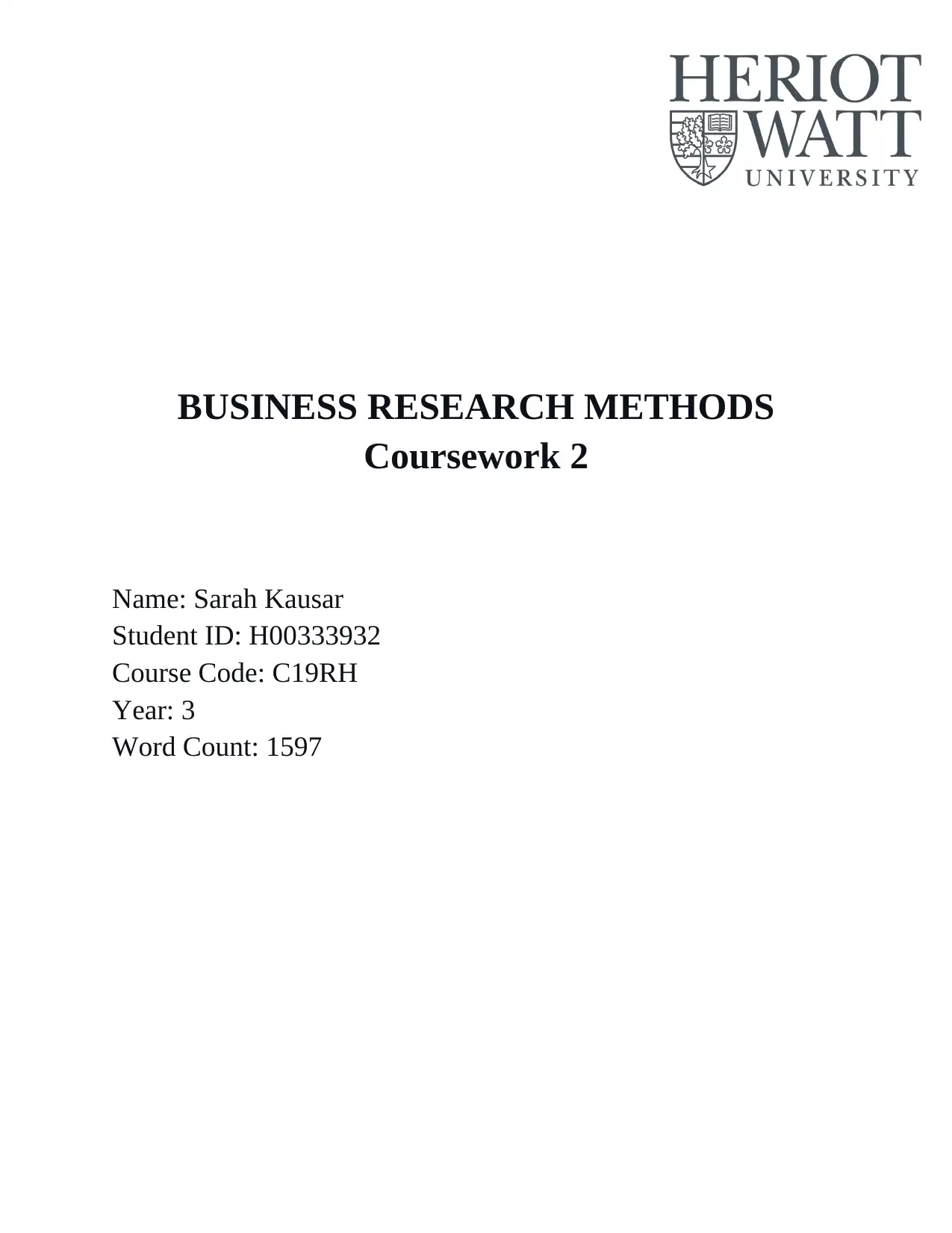
BUSINESS RESEARCH METHODS
Coursework 2
Name: Sarah Kausar
Student ID: H00333932
Course Code: C19RH
Year: 3
Word Count: 1597
Coursework 2
Name: Sarah Kausar
Student ID: H00333932
Course Code: C19RH
Year: 3
Word Count: 1597
Secure Best Marks with AI Grader
Need help grading? Try our AI Grader for instant feedback on your assignments.
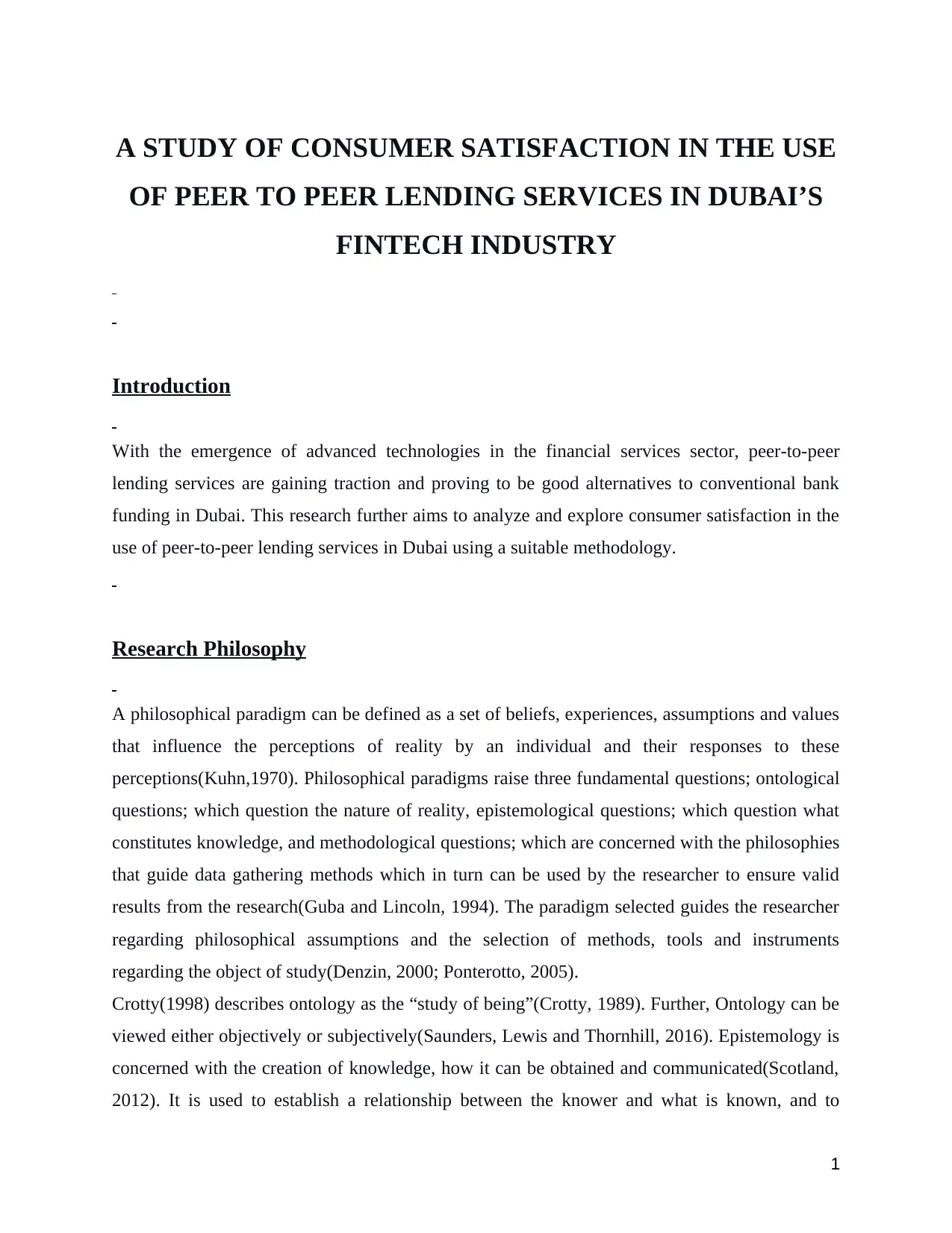
A STUDY OF CONSUMER SATISFACTION IN THE USE
OF PEER TO PEER LENDING SERVICES IN DUBAI’S
FINTECH INDUSTRY
Introduction
With the emergence of advanced technologies in the financial services sector, peer-to-peer
lending services are gaining traction and proving to be good alternatives to conventional bank
funding in Dubai. This research further aims to analyze and explore consumer satisfaction in the
use of peer-to-peer lending services in Dubai using a suitable methodology.
Research Philosophy
A philosophical paradigm can be defined as a set of beliefs, experiences, assumptions and values
that influence the perceptions of reality by an individual and their responses to these
perceptions(Kuhn,1970). Philosophical paradigms raise three fundamental questions; ontological
questions; which question the nature of reality, epistemological questions; which question what
constitutes knowledge, and methodological questions; which are concerned with the philosophies
that guide data gathering methods which in turn can be used by the researcher to ensure valid
results from the research(Guba and Lincoln, 1994). The paradigm selected guides the researcher
regarding philosophical assumptions and the selection of methods, tools and instruments
regarding the object of study(Denzin, 2000; Ponterotto, 2005).
Crotty(1998) describes ontology as the “study of being”(Crotty, 1989). Further, Ontology can be
viewed either objectively or subjectively(Saunders, Lewis and Thornhill, 2016). Epistemology is
concerned with the creation of knowledge, how it can be obtained and communicated(Scotland,
2012). It is used to establish a relationship between the knower and what is known, and to
1
OF PEER TO PEER LENDING SERVICES IN DUBAI’S
FINTECH INDUSTRY
Introduction
With the emergence of advanced technologies in the financial services sector, peer-to-peer
lending services are gaining traction and proving to be good alternatives to conventional bank
funding in Dubai. This research further aims to analyze and explore consumer satisfaction in the
use of peer-to-peer lending services in Dubai using a suitable methodology.
Research Philosophy
A philosophical paradigm can be defined as a set of beliefs, experiences, assumptions and values
that influence the perceptions of reality by an individual and their responses to these
perceptions(Kuhn,1970). Philosophical paradigms raise three fundamental questions; ontological
questions; which question the nature of reality, epistemological questions; which question what
constitutes knowledge, and methodological questions; which are concerned with the philosophies
that guide data gathering methods which in turn can be used by the researcher to ensure valid
results from the research(Guba and Lincoln, 1994). The paradigm selected guides the researcher
regarding philosophical assumptions and the selection of methods, tools and instruments
regarding the object of study(Denzin, 2000; Ponterotto, 2005).
Crotty(1998) describes ontology as the “study of being”(Crotty, 1989). Further, Ontology can be
viewed either objectively or subjectively(Saunders, Lewis and Thornhill, 2016). Epistemology is
concerned with the creation of knowledge, how it can be obtained and communicated(Scotland,
2012). It is used to establish a relationship between the knower and what is known, and to
1
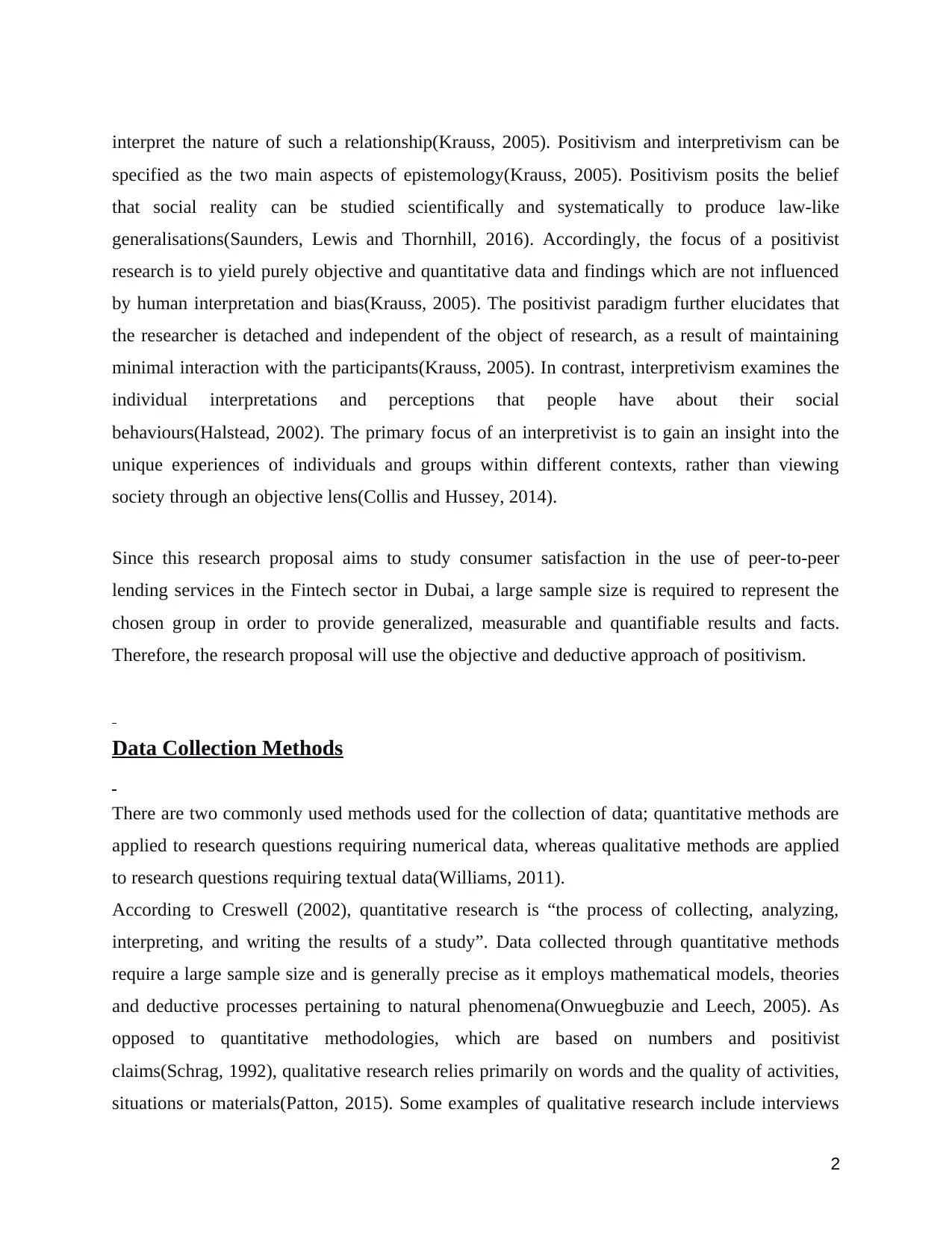
interpret the nature of such a relationship(Krauss, 2005). Positivism and interpretivism can be
specified as the two main aspects of epistemology(Krauss, 2005). Positivism posits the belief
that social reality can be studied scientifically and systematically to produce law-like
generalisations(Saunders, Lewis and Thornhill, 2016). Accordingly, the focus of a positivist
research is to yield purely objective and quantitative data and findings which are not influenced
by human interpretation and bias(Krauss, 2005). The positivist paradigm further elucidates that
the researcher is detached and independent of the object of research, as a result of maintaining
minimal interaction with the participants(Krauss, 2005). In contrast, interpretivism examines the
individual interpretations and perceptions that people have about their social
behaviours(Halstead, 2002). The primary focus of an interpretivist is to gain an insight into the
unique experiences of individuals and groups within different contexts, rather than viewing
society through an objective lens(Collis and Hussey, 2014).
Since this research proposal aims to study consumer satisfaction in the use of peer-to-peer
lending services in the Fintech sector in Dubai, a large sample size is required to represent the
chosen group in order to provide generalized, measurable and quantifiable results and facts.
Therefore, the research proposal will use the objective and deductive approach of positivism.
Data Collection Methods
There are two commonly used methods used for the collection of data; quantitative methods are
applied to research questions requiring numerical data, whereas qualitative methods are applied
to research questions requiring textual data(Williams, 2011).
According to Creswell (2002), quantitative research is “the process of collecting, analyzing,
interpreting, and writing the results of a study”. Data collected through quantitative methods
require a large sample size and is generally precise as it employs mathematical models, theories
and deductive processes pertaining to natural phenomena(Onwuegbuzie and Leech, 2005). As
opposed to quantitative methodologies, which are based on numbers and positivist
claims(Schrag, 1992), qualitative research relies primarily on words and the quality of activities,
situations or materials(Patton, 2015). Some examples of qualitative research include interviews
2
specified as the two main aspects of epistemology(Krauss, 2005). Positivism posits the belief
that social reality can be studied scientifically and systematically to produce law-like
generalisations(Saunders, Lewis and Thornhill, 2016). Accordingly, the focus of a positivist
research is to yield purely objective and quantitative data and findings which are not influenced
by human interpretation and bias(Krauss, 2005). The positivist paradigm further elucidates that
the researcher is detached and independent of the object of research, as a result of maintaining
minimal interaction with the participants(Krauss, 2005). In contrast, interpretivism examines the
individual interpretations and perceptions that people have about their social
behaviours(Halstead, 2002). The primary focus of an interpretivist is to gain an insight into the
unique experiences of individuals and groups within different contexts, rather than viewing
society through an objective lens(Collis and Hussey, 2014).
Since this research proposal aims to study consumer satisfaction in the use of peer-to-peer
lending services in the Fintech sector in Dubai, a large sample size is required to represent the
chosen group in order to provide generalized, measurable and quantifiable results and facts.
Therefore, the research proposal will use the objective and deductive approach of positivism.
Data Collection Methods
There are two commonly used methods used for the collection of data; quantitative methods are
applied to research questions requiring numerical data, whereas qualitative methods are applied
to research questions requiring textual data(Williams, 2011).
According to Creswell (2002), quantitative research is “the process of collecting, analyzing,
interpreting, and writing the results of a study”. Data collected through quantitative methods
require a large sample size and is generally precise as it employs mathematical models, theories
and deductive processes pertaining to natural phenomena(Onwuegbuzie and Leech, 2005). As
opposed to quantitative methodologies, which are based on numbers and positivist
claims(Schrag, 1992), qualitative research relies primarily on words and the quality of activities,
situations or materials(Patton, 2015). Some examples of qualitative research include interviews
2
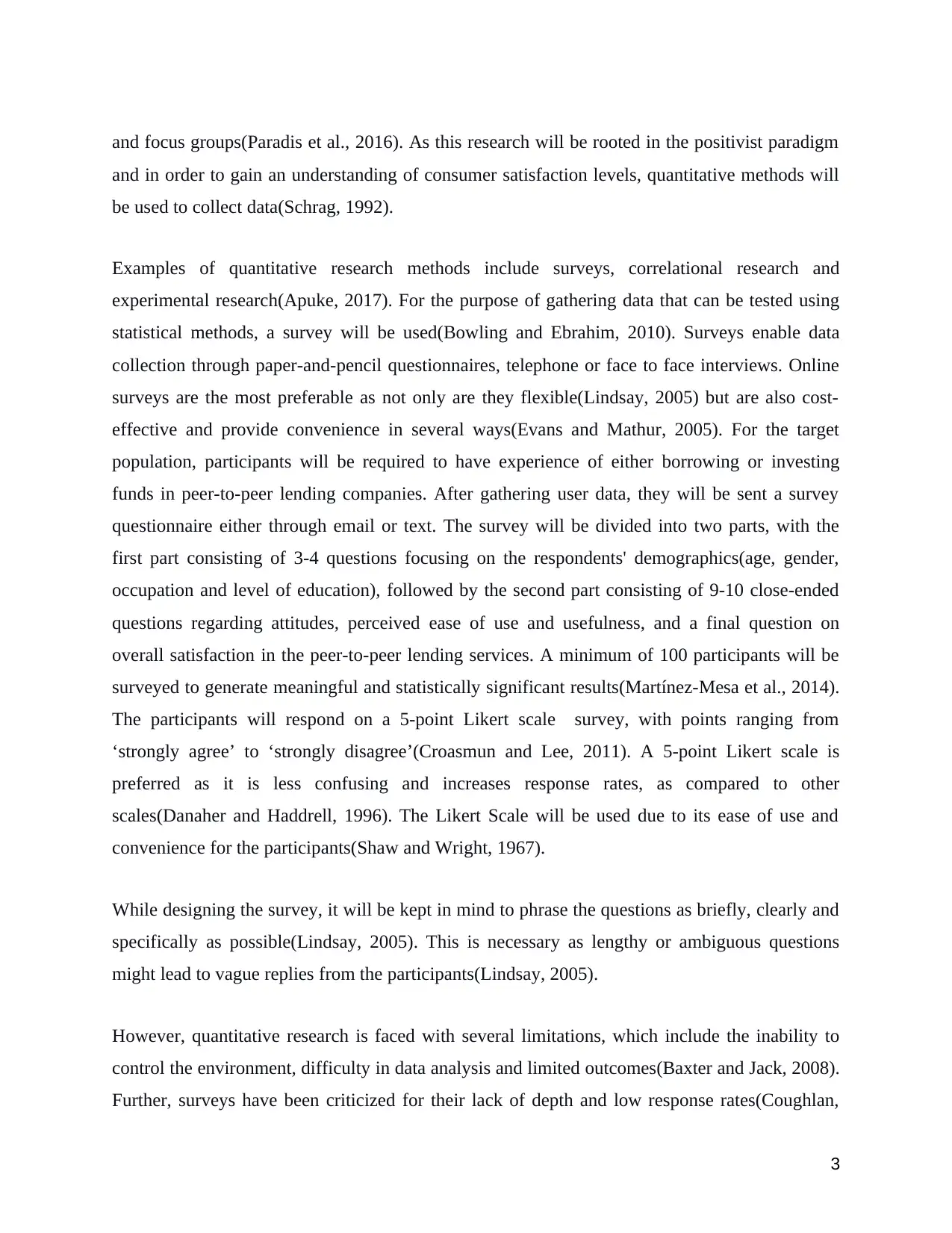
and focus groups(Paradis et al., 2016). As this research will be rooted in the positivist paradigm
and in order to gain an understanding of consumer satisfaction levels, quantitative methods will
be used to collect data(Schrag, 1992).
Examples of quantitative research methods include surveys, correlational research and
experimental research(Apuke, 2017). For the purpose of gathering data that can be tested using
statistical methods, a survey will be used(Bowling and Ebrahim, 2010). Surveys enable data
collection through paper-and-pencil questionnaires, telephone or face to face interviews. Online
surveys are the most preferable as not only are they flexible(Lindsay, 2005) but are also cost-
effective and provide convenience in several ways(Evans and Mathur, 2005). For the target
population, participants will be required to have experience of either borrowing or investing
funds in peer-to-peer lending companies. After gathering user data, they will be sent a survey
questionnaire either through email or text. The survey will be divided into two parts, with the
first part consisting of 3-4 questions focusing on the respondents' demographics(age, gender,
occupation and level of education), followed by the second part consisting of 9-10 close-ended
questions regarding attitudes, perceived ease of use and usefulness, and a final question on
overall satisfaction in the peer-to-peer lending services. A minimum of 100 participants will be
surveyed to generate meaningful and statistically significant results(Martínez-Mesa et al., 2014).
The participants will respond on a 5-point Likert scale survey, with points ranging from
‘strongly agree’ to ‘strongly disagree’(Croasmun and Lee, 2011). A 5-point Likert scale is
preferred as it is less confusing and increases response rates, as compared to other
scales(Danaher and Haddrell, 1996). The Likert Scale will be used due to its ease of use and
convenience for the participants(Shaw and Wright, 1967).
While designing the survey, it will be kept in mind to phrase the questions as briefly, clearly and
specifically as possible(Lindsay, 2005). This is necessary as lengthy or ambiguous questions
might lead to vague replies from the participants(Lindsay, 2005).
However, quantitative research is faced with several limitations, which include the inability to
control the environment, difficulty in data analysis and limited outcomes(Baxter and Jack, 2008).
Further, surveys have been criticized for their lack of depth and low response rates(Coughlan,
3
and in order to gain an understanding of consumer satisfaction levels, quantitative methods will
be used to collect data(Schrag, 1992).
Examples of quantitative research methods include surveys, correlational research and
experimental research(Apuke, 2017). For the purpose of gathering data that can be tested using
statistical methods, a survey will be used(Bowling and Ebrahim, 2010). Surveys enable data
collection through paper-and-pencil questionnaires, telephone or face to face interviews. Online
surveys are the most preferable as not only are they flexible(Lindsay, 2005) but are also cost-
effective and provide convenience in several ways(Evans and Mathur, 2005). For the target
population, participants will be required to have experience of either borrowing or investing
funds in peer-to-peer lending companies. After gathering user data, they will be sent a survey
questionnaire either through email or text. The survey will be divided into two parts, with the
first part consisting of 3-4 questions focusing on the respondents' demographics(age, gender,
occupation and level of education), followed by the second part consisting of 9-10 close-ended
questions regarding attitudes, perceived ease of use and usefulness, and a final question on
overall satisfaction in the peer-to-peer lending services. A minimum of 100 participants will be
surveyed to generate meaningful and statistically significant results(Martínez-Mesa et al., 2014).
The participants will respond on a 5-point Likert scale survey, with points ranging from
‘strongly agree’ to ‘strongly disagree’(Croasmun and Lee, 2011). A 5-point Likert scale is
preferred as it is less confusing and increases response rates, as compared to other
scales(Danaher and Haddrell, 1996). The Likert Scale will be used due to its ease of use and
convenience for the participants(Shaw and Wright, 1967).
While designing the survey, it will be kept in mind to phrase the questions as briefly, clearly and
specifically as possible(Lindsay, 2005). This is necessary as lengthy or ambiguous questions
might lead to vague replies from the participants(Lindsay, 2005).
However, quantitative research is faced with several limitations, which include the inability to
control the environment, difficulty in data analysis and limited outcomes(Baxter and Jack, 2008).
Further, surveys have been criticized for their lack of depth and low response rates(Coughlan,
3
Secure Best Marks with AI Grader
Need help grading? Try our AI Grader for instant feedback on your assignments.
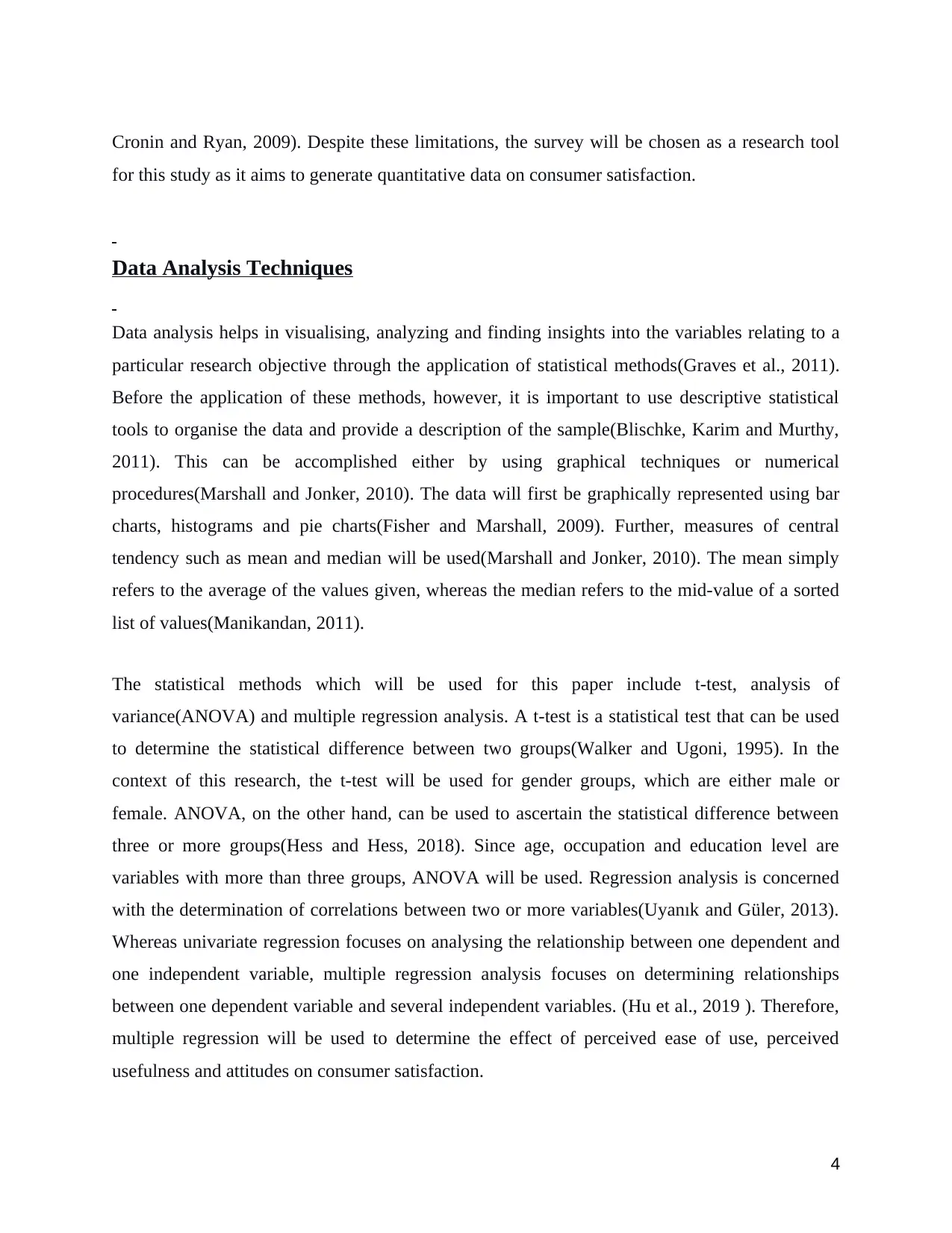
Cronin and Ryan, 2009). Despite these limitations, the survey will be chosen as a research tool
for this study as it aims to generate quantitative data on consumer satisfaction.
Data Analysis Techniques
Data analysis helps in visualising, analyzing and finding insights into the variables relating to a
particular research objective through the application of statistical methods(Graves et al., 2011).
Before the application of these methods, however, it is important to use descriptive statistical
tools to organise the data and provide a description of the sample(Blischke, Karim and Murthy,
2011). This can be accomplished either by using graphical techniques or numerical
procedures(Marshall and Jonker, 2010). The data will first be graphically represented using bar
charts, histograms and pie charts(Fisher and Marshall, 2009). Further, measures of central
tendency such as mean and median will be used(Marshall and Jonker, 2010). The mean simply
refers to the average of the values given, whereas the median refers to the mid-value of a sorted
list of values(Manikandan, 2011).
The statistical methods which will be used for this paper include t-test, analysis of
variance(ANOVA) and multiple regression analysis. A t-test is a statistical test that can be used
to determine the statistical difference between two groups(Walker and Ugoni, 1995). In the
context of this research, the t-test will be used for gender groups, which are either male or
female. ANOVA, on the other hand, can be used to ascertain the statistical difference between
three or more groups(Hess and Hess, 2018). Since age, occupation and education level are
variables with more than three groups, ANOVA will be used. Regression analysis is concerned
with the determination of correlations between two or more variables(Uyanık and Güler, 2013).
Whereas univariate regression focuses on analysing the relationship between one dependent and
one independent variable, multiple regression analysis focuses on determining relationships
between one dependent variable and several independent variables. (Hu et al., 2019 ). Therefore,
multiple regression will be used to determine the effect of perceived ease of use, perceived
usefulness and attitudes on consumer satisfaction.
4
for this study as it aims to generate quantitative data on consumer satisfaction.
Data Analysis Techniques
Data analysis helps in visualising, analyzing and finding insights into the variables relating to a
particular research objective through the application of statistical methods(Graves et al., 2011).
Before the application of these methods, however, it is important to use descriptive statistical
tools to organise the data and provide a description of the sample(Blischke, Karim and Murthy,
2011). This can be accomplished either by using graphical techniques or numerical
procedures(Marshall and Jonker, 2010). The data will first be graphically represented using bar
charts, histograms and pie charts(Fisher and Marshall, 2009). Further, measures of central
tendency such as mean and median will be used(Marshall and Jonker, 2010). The mean simply
refers to the average of the values given, whereas the median refers to the mid-value of a sorted
list of values(Manikandan, 2011).
The statistical methods which will be used for this paper include t-test, analysis of
variance(ANOVA) and multiple regression analysis. A t-test is a statistical test that can be used
to determine the statistical difference between two groups(Walker and Ugoni, 1995). In the
context of this research, the t-test will be used for gender groups, which are either male or
female. ANOVA, on the other hand, can be used to ascertain the statistical difference between
three or more groups(Hess and Hess, 2018). Since age, occupation and education level are
variables with more than three groups, ANOVA will be used. Regression analysis is concerned
with the determination of correlations between two or more variables(Uyanık and Güler, 2013).
Whereas univariate regression focuses on analysing the relationship between one dependent and
one independent variable, multiple regression analysis focuses on determining relationships
between one dependent variable and several independent variables. (Hu et al., 2019 ). Therefore,
multiple regression will be used to determine the effect of perceived ease of use, perceived
usefulness and attitudes on consumer satisfaction.
4
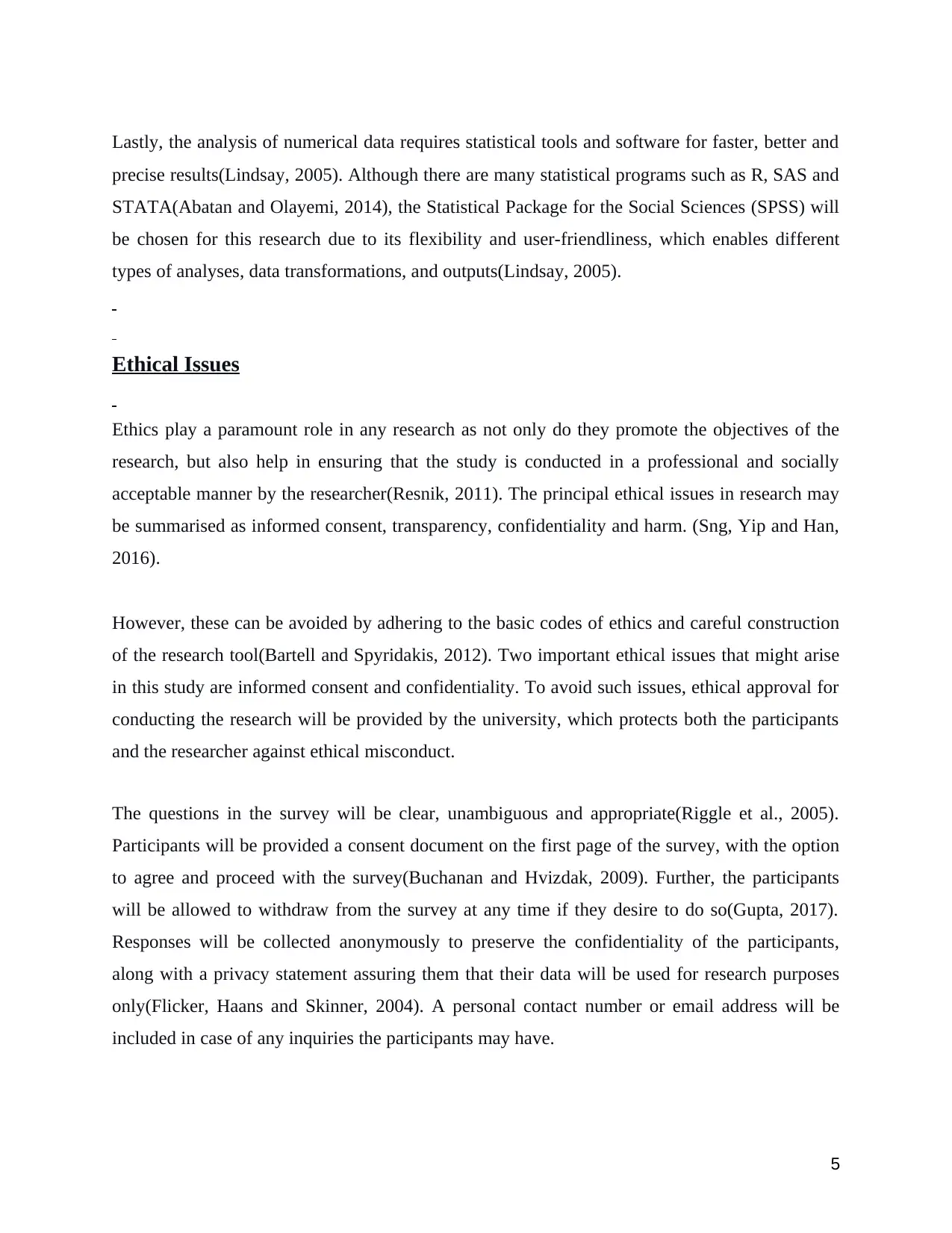
Lastly, the analysis of numerical data requires statistical tools and software for faster, better and
precise results(Lindsay, 2005). Although there are many statistical programs such as R, SAS and
STATA(Abatan and Olayemi, 2014), the Statistical Package for the Social Sciences (SPSS) will
be chosen for this research due to its flexibility and user-friendliness, which enables different
types of analyses, data transformations, and outputs(Lindsay, 2005).
Ethical Issues
Ethics play a paramount role in any research as not only do they promote the objectives of the
research, but also help in ensuring that the study is conducted in a professional and socially
acceptable manner by the researcher(Resnik, 2011). The principal ethical issues in research may
be summarised as informed consent, transparency, confidentiality and harm. (Sng, Yip and Han,
2016).
However, these can be avoided by adhering to the basic codes of ethics and careful construction
of the research tool(Bartell and Spyridakis, 2012). Two important ethical issues that might arise
in this study are informed consent and confidentiality. To avoid such issues, ethical approval for
conducting the research will be provided by the university, which protects both the participants
and the researcher against ethical misconduct.
The questions in the survey will be clear, unambiguous and appropriate(Riggle et al., 2005).
Participants will be provided a consent document on the first page of the survey, with the option
to agree and proceed with the survey(Buchanan and Hvizdak, 2009). Further, the participants
will be allowed to withdraw from the survey at any time if they desire to do so(Gupta, 2017).
Responses will be collected anonymously to preserve the confidentiality of the participants,
along with a privacy statement assuring them that their data will be used for research purposes
only(Flicker, Haans and Skinner, 2004). A personal contact number or email address will be
included in case of any inquiries the participants may have.
5
precise results(Lindsay, 2005). Although there are many statistical programs such as R, SAS and
STATA(Abatan and Olayemi, 2014), the Statistical Package for the Social Sciences (SPSS) will
be chosen for this research due to its flexibility and user-friendliness, which enables different
types of analyses, data transformations, and outputs(Lindsay, 2005).
Ethical Issues
Ethics play a paramount role in any research as not only do they promote the objectives of the
research, but also help in ensuring that the study is conducted in a professional and socially
acceptable manner by the researcher(Resnik, 2011). The principal ethical issues in research may
be summarised as informed consent, transparency, confidentiality and harm. (Sng, Yip and Han,
2016).
However, these can be avoided by adhering to the basic codes of ethics and careful construction
of the research tool(Bartell and Spyridakis, 2012). Two important ethical issues that might arise
in this study are informed consent and confidentiality. To avoid such issues, ethical approval for
conducting the research will be provided by the university, which protects both the participants
and the researcher against ethical misconduct.
The questions in the survey will be clear, unambiguous and appropriate(Riggle et al., 2005).
Participants will be provided a consent document on the first page of the survey, with the option
to agree and proceed with the survey(Buchanan and Hvizdak, 2009). Further, the participants
will be allowed to withdraw from the survey at any time if they desire to do so(Gupta, 2017).
Responses will be collected anonymously to preserve the confidentiality of the participants,
along with a privacy statement assuring them that their data will be used for research purposes
only(Flicker, Haans and Skinner, 2004). A personal contact number or email address will be
included in case of any inquiries the participants may have.
5

To further ensure the security of the data collected, data encryption and password-protected
computer directories such as google cloud server and OneDrive will be used for storage(Gupta,
2017).
References
6
computer directories such as google cloud server and OneDrive will be used for storage(Gupta,
2017).
References
6
Paraphrase This Document
Need a fresh take? Get an instant paraphrase of this document with our AI Paraphraser
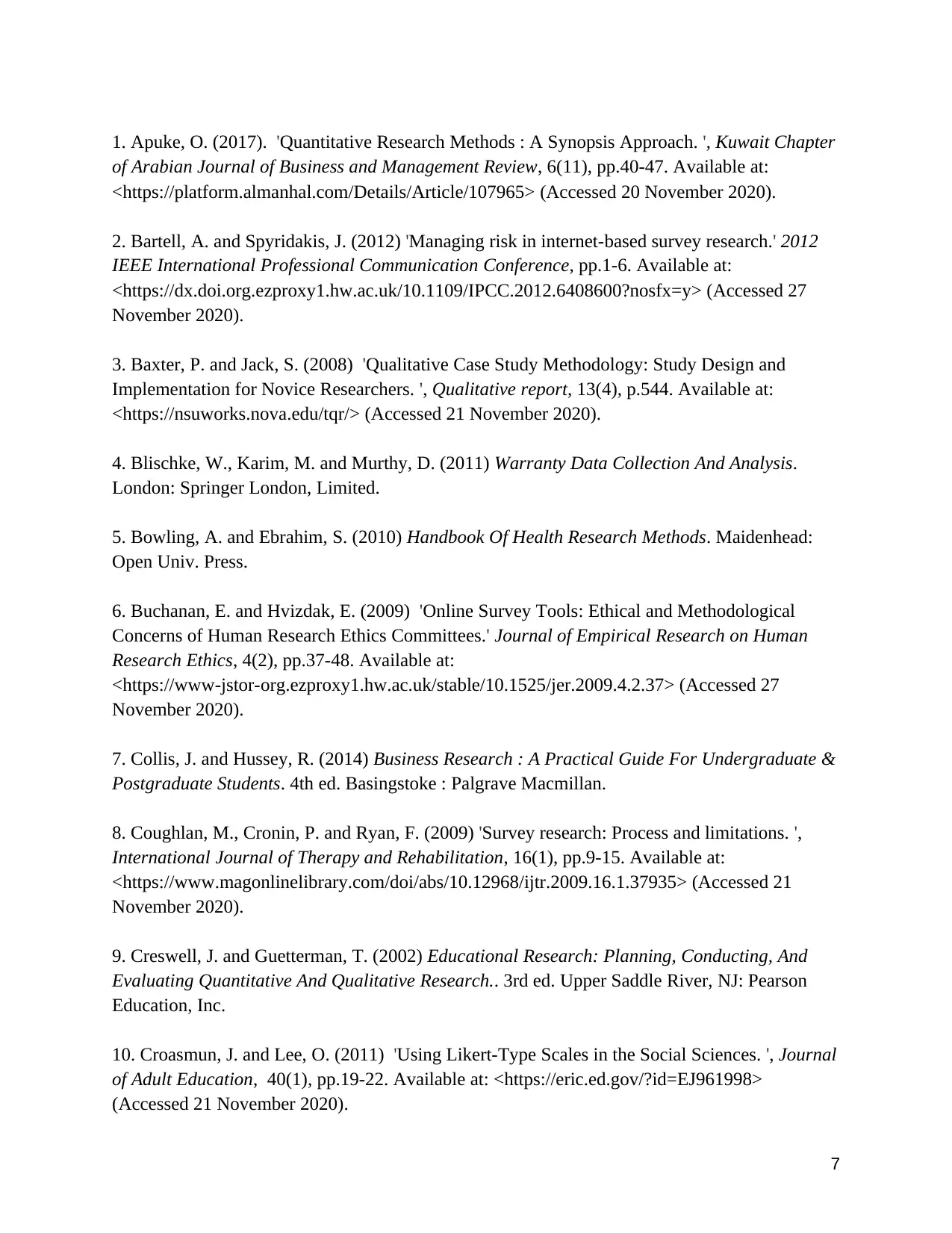
1. Apuke, O. (2017). 'Quantitative Research Methods : A Synopsis Approach. ', Kuwait Chapter
of Arabian Journal of Business and Management Review, 6(11), pp.40-47. Available at:
<https://platform.almanhal.com/Details/Article/107965> (Accessed 20 November 2020).
2. Bartell, A. and Spyridakis, J. (2012) 'Managing risk in internet-based survey research.' 2012
IEEE International Professional Communication Conference, pp.1-6. Available at:
<https://dx.doi.org.ezproxy1.hw.ac.uk/10.1109/IPCC.2012.6408600?nosfx=y> (Accessed 27
November 2020).
3. Baxter, P. and Jack, S. (2008) 'Qualitative Case Study Methodology: Study Design and
Implementation for Novice Researchers. ', Qualitative report, 13(4), p.544. Available at:
<https://nsuworks.nova.edu/tqr/> (Accessed 21 November 2020).
4. Blischke, W., Karim, M. and Murthy, D. (2011) Warranty Data Collection And Analysis.
London: Springer London, Limited.
5. Bowling, A. and Ebrahim, S. (2010) Handbook Of Health Research Methods. Maidenhead:
Open Univ. Press.
6. Buchanan, E. and Hvizdak, E. (2009) 'Online Survey Tools: Ethical and Methodological
Concerns of Human Research Ethics Committees.' Journal of Empirical Research on Human
Research Ethics, 4(2), pp.37-48. Available at:
<https://www-jstor-org.ezproxy1.hw.ac.uk/stable/10.1525/jer.2009.4.2.37> (Accessed 27
November 2020).
7. Collis, J. and Hussey, R. (2014) Business Research : A Practical Guide For Undergraduate &
Postgraduate Students. 4th ed. Basingstoke : Palgrave Macmillan.
8. Coughlan, M., Cronin, P. and Ryan, F. (2009) 'Survey research: Process and limitations. ',
International Journal of Therapy and Rehabilitation, 16(1), pp.9-15. Available at:
<https://www.magonlinelibrary.com/doi/abs/10.12968/ijtr.2009.16.1.37935> (Accessed 21
November 2020).
9. Creswell, J. and Guetterman, T. (2002) Educational Research: Planning, Conducting, And
Evaluating Quantitative And Qualitative Research.. 3rd ed. Upper Saddle River, NJ: Pearson
Education, Inc.
10. Croasmun, J. and Lee, O. (2011) 'Using Likert-Type Scales in the Social Sciences. ', Journal
of Adult Education, 40(1), pp.19-22. Available at: <https://eric.ed.gov/?id=EJ961998>
(Accessed 21 November 2020).
7
of Arabian Journal of Business and Management Review, 6(11), pp.40-47. Available at:
<https://platform.almanhal.com/Details/Article/107965> (Accessed 20 November 2020).
2. Bartell, A. and Spyridakis, J. (2012) 'Managing risk in internet-based survey research.' 2012
IEEE International Professional Communication Conference, pp.1-6. Available at:
<https://dx.doi.org.ezproxy1.hw.ac.uk/10.1109/IPCC.2012.6408600?nosfx=y> (Accessed 27
November 2020).
3. Baxter, P. and Jack, S. (2008) 'Qualitative Case Study Methodology: Study Design and
Implementation for Novice Researchers. ', Qualitative report, 13(4), p.544. Available at:
<https://nsuworks.nova.edu/tqr/> (Accessed 21 November 2020).
4. Blischke, W., Karim, M. and Murthy, D. (2011) Warranty Data Collection And Analysis.
London: Springer London, Limited.
5. Bowling, A. and Ebrahim, S. (2010) Handbook Of Health Research Methods. Maidenhead:
Open Univ. Press.
6. Buchanan, E. and Hvizdak, E. (2009) 'Online Survey Tools: Ethical and Methodological
Concerns of Human Research Ethics Committees.' Journal of Empirical Research on Human
Research Ethics, 4(2), pp.37-48. Available at:
<https://www-jstor-org.ezproxy1.hw.ac.uk/stable/10.1525/jer.2009.4.2.37> (Accessed 27
November 2020).
7. Collis, J. and Hussey, R. (2014) Business Research : A Practical Guide For Undergraduate &
Postgraduate Students. 4th ed. Basingstoke : Palgrave Macmillan.
8. Coughlan, M., Cronin, P. and Ryan, F. (2009) 'Survey research: Process and limitations. ',
International Journal of Therapy and Rehabilitation, 16(1), pp.9-15. Available at:
<https://www.magonlinelibrary.com/doi/abs/10.12968/ijtr.2009.16.1.37935> (Accessed 21
November 2020).
9. Creswell, J. and Guetterman, T. (2002) Educational Research: Planning, Conducting, And
Evaluating Quantitative And Qualitative Research.. 3rd ed. Upper Saddle River, NJ: Pearson
Education, Inc.
10. Croasmun, J. and Lee, O. (2011) 'Using Likert-Type Scales in the Social Sciences. ', Journal
of Adult Education, 40(1), pp.19-22. Available at: <https://eric.ed.gov/?id=EJ961998>
(Accessed 21 November 2020).
7
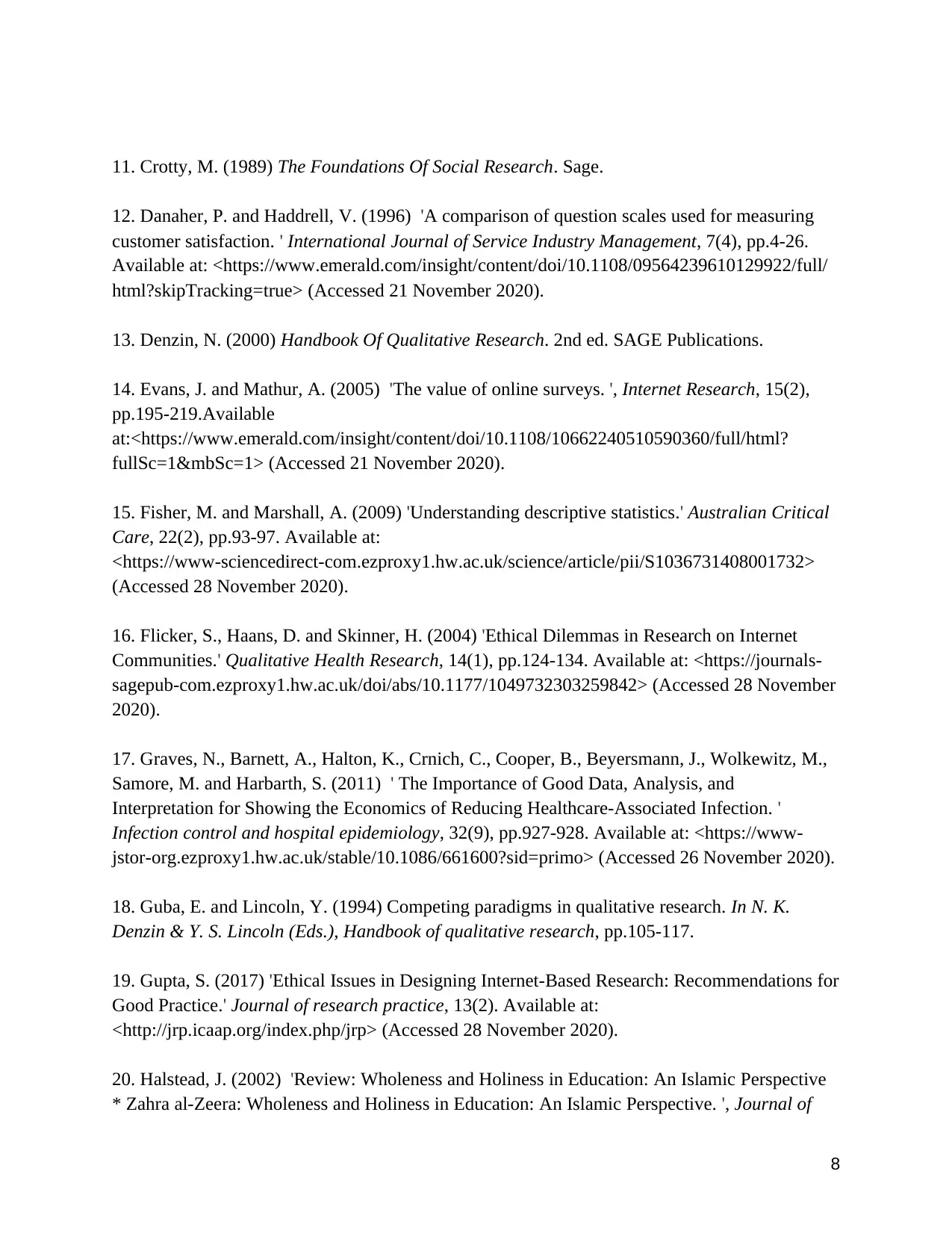
11. Crotty, M. (1989) The Foundations Of Social Research. Sage.
12. Danaher, P. and Haddrell, V. (1996) 'A comparison of question scales used for measuring
customer satisfaction. ' International Journal of Service Industry Management, 7(4), pp.4-26.
Available at: <https://www.emerald.com/insight/content/doi/10.1108/09564239610129922/full/
html?skipTracking=true> (Accessed 21 November 2020).
13. Denzin, N. (2000) Handbook Of Qualitative Research. 2nd ed. SAGE Publications.
14. Evans, J. and Mathur, A. (2005) 'The value of online surveys. ', Internet Research, 15(2),
pp.195-219.Available
at:<https://www.emerald.com/insight/content/doi/10.1108/10662240510590360/full/html?
fullSc=1&mbSc=1> (Accessed 21 November 2020).
15. Fisher, M. and Marshall, A. (2009) 'Understanding descriptive statistics.' Australian Critical
Care, 22(2), pp.93-97. Available at:
<https://www-sciencedirect-com.ezproxy1.hw.ac.uk/science/article/pii/S1036731408001732>
(Accessed 28 November 2020).
16. Flicker, S., Haans, D. and Skinner, H. (2004) 'Ethical Dilemmas in Research on Internet
Communities.' Qualitative Health Research, 14(1), pp.124-134. Available at: <https://journals-
sagepub-com.ezproxy1.hw.ac.uk/doi/abs/10.1177/1049732303259842> (Accessed 28 November
2020).
17. Graves, N., Barnett, A., Halton, K., Crnich, C., Cooper, B., Beyersmann, J., Wolkewitz, M.,
Samore, M. and Harbarth, S. (2011) ' The Importance of Good Data, Analysis, and
Interpretation for Showing the Economics of Reducing Healthcare-Associated Infection. '
Infection control and hospital epidemiology, 32(9), pp.927-928. Available at: <https://www-
jstor-org.ezproxy1.hw.ac.uk/stable/10.1086/661600?sid=primo> (Accessed 26 November 2020).
18. Guba, E. and Lincoln, Y. (1994) Competing paradigms in qualitative research. In N. K.
Denzin & Y. S. Lincoln (Eds.), Handbook of qualitative research, pp.105-117.
19. Gupta, S. (2017) 'Ethical Issues in Designing Internet-Based Research: Recommendations for
Good Practice.' Journal of research practice, 13(2). Available at:
<http://jrp.icaap.org/index.php/jrp> (Accessed 28 November 2020).
20. Halstead, J. (2002) 'Review: Wholeness and Holiness in Education: An Islamic Perspective
* Zahra al-Zeera: Wholeness and Holiness in Education: An Islamic Perspective. ', Journal of
8
12. Danaher, P. and Haddrell, V. (1996) 'A comparison of question scales used for measuring
customer satisfaction. ' International Journal of Service Industry Management, 7(4), pp.4-26.
Available at: <https://www.emerald.com/insight/content/doi/10.1108/09564239610129922/full/
html?skipTracking=true> (Accessed 21 November 2020).
13. Denzin, N. (2000) Handbook Of Qualitative Research. 2nd ed. SAGE Publications.
14. Evans, J. and Mathur, A. (2005) 'The value of online surveys. ', Internet Research, 15(2),
pp.195-219.Available
at:<https://www.emerald.com/insight/content/doi/10.1108/10662240510590360/full/html?
fullSc=1&mbSc=1> (Accessed 21 November 2020).
15. Fisher, M. and Marshall, A. (2009) 'Understanding descriptive statistics.' Australian Critical
Care, 22(2), pp.93-97. Available at:
<https://www-sciencedirect-com.ezproxy1.hw.ac.uk/science/article/pii/S1036731408001732>
(Accessed 28 November 2020).
16. Flicker, S., Haans, D. and Skinner, H. (2004) 'Ethical Dilemmas in Research on Internet
Communities.' Qualitative Health Research, 14(1), pp.124-134. Available at: <https://journals-
sagepub-com.ezproxy1.hw.ac.uk/doi/abs/10.1177/1049732303259842> (Accessed 28 November
2020).
17. Graves, N., Barnett, A., Halton, K., Crnich, C., Cooper, B., Beyersmann, J., Wolkewitz, M.,
Samore, M. and Harbarth, S. (2011) ' The Importance of Good Data, Analysis, and
Interpretation for Showing the Economics of Reducing Healthcare-Associated Infection. '
Infection control and hospital epidemiology, 32(9), pp.927-928. Available at: <https://www-
jstor-org.ezproxy1.hw.ac.uk/stable/10.1086/661600?sid=primo> (Accessed 26 November 2020).
18. Guba, E. and Lincoln, Y. (1994) Competing paradigms in qualitative research. In N. K.
Denzin & Y. S. Lincoln (Eds.), Handbook of qualitative research, pp.105-117.
19. Gupta, S. (2017) 'Ethical Issues in Designing Internet-Based Research: Recommendations for
Good Practice.' Journal of research practice, 13(2). Available at:
<http://jrp.icaap.org/index.php/jrp> (Accessed 28 November 2020).
20. Halstead, J. (2002) 'Review: Wholeness and Holiness in Education: An Islamic Perspective
* Zahra al-Zeera: Wholeness and Holiness in Education: An Islamic Perspective. ', Journal of
8
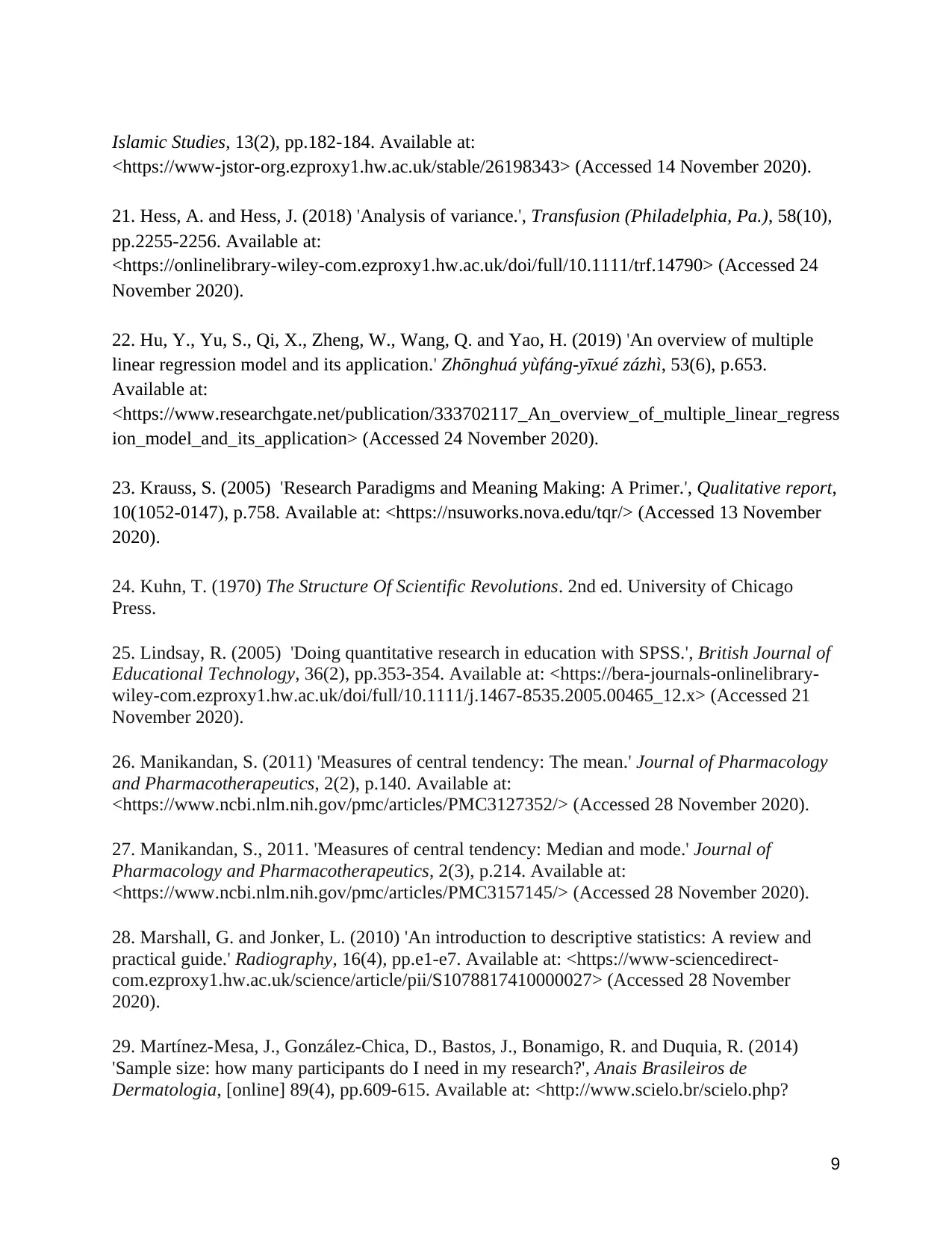
Islamic Studies, 13(2), pp.182-184. Available at:
<https://www-jstor-org.ezproxy1.hw.ac.uk/stable/26198343> (Accessed 14 November 2020).
21. Hess, A. and Hess, J. (2018) 'Analysis of variance.', Transfusion (Philadelphia, Pa.), 58(10),
pp.2255-2256. Available at:
<https://onlinelibrary-wiley-com.ezproxy1.hw.ac.uk/doi/full/10.1111/trf.14790> (Accessed 24
November 2020).
22. Hu, Y., Yu, S., Qi, X., Zheng, W., Wang, Q. and Yao, H. (2019) 'An overview of multiple
linear regression model and its application.' Zhōnghuá yùfáng-yīxué zázhì, 53(6), p.653.
Available at:
<https://www.researchgate.net/publication/333702117_An_overview_of_multiple_linear_regress
ion_model_and_its_application> (Accessed 24 November 2020).
23. Krauss, S. (2005) 'Research Paradigms and Meaning Making: A Primer.', Qualitative report,
10(1052-0147), p.758. Available at: <https://nsuworks.nova.edu/tqr/> (Accessed 13 November
2020).
24. Kuhn, T. (1970) The Structure Of Scientific Revolutions. 2nd ed. University of Chicago
Press.
25. Lindsay, R. (2005) 'Doing quantitative research in education with SPSS.', British Journal of
Educational Technology, 36(2), pp.353-354. Available at: <https://bera-journals-onlinelibrary-
wiley-com.ezproxy1.hw.ac.uk/doi/full/10.1111/j.1467-8535.2005.00465_12.x> (Accessed 21
November 2020).
26. Manikandan, S. (2011) 'Measures of central tendency: The mean.' Journal of Pharmacology
and Pharmacotherapeutics, 2(2), p.140. Available at:
<https://www.ncbi.nlm.nih.gov/pmc/articles/PMC3127352/> (Accessed 28 November 2020).
27. Manikandan, S., 2011. 'Measures of central tendency: Median and mode.' Journal of
Pharmacology and Pharmacotherapeutics, 2(3), p.214. Available at:
<https://www.ncbi.nlm.nih.gov/pmc/articles/PMC3157145/> (Accessed 28 November 2020).
28. Marshall, G. and Jonker, L. (2010) 'An introduction to descriptive statistics: A review and
practical guide.' Radiography, 16(4), pp.e1-e7. Available at: <https://www-sciencedirect-
com.ezproxy1.hw.ac.uk/science/article/pii/S1078817410000027> (Accessed 28 November
2020).
29. Martínez-Mesa, J., González-Chica, D., Bastos, J., Bonamigo, R. and Duquia, R. (2014)
'Sample size: how many participants do I need in my research?', Anais Brasileiros de
Dermatologia, [online] 89(4), pp.609-615. Available at: <http://www.scielo.br/scielo.php?
9
<https://www-jstor-org.ezproxy1.hw.ac.uk/stable/26198343> (Accessed 14 November 2020).
21. Hess, A. and Hess, J. (2018) 'Analysis of variance.', Transfusion (Philadelphia, Pa.), 58(10),
pp.2255-2256. Available at:
<https://onlinelibrary-wiley-com.ezproxy1.hw.ac.uk/doi/full/10.1111/trf.14790> (Accessed 24
November 2020).
22. Hu, Y., Yu, S., Qi, X., Zheng, W., Wang, Q. and Yao, H. (2019) 'An overview of multiple
linear regression model and its application.' Zhōnghuá yùfáng-yīxué zázhì, 53(6), p.653.
Available at:
<https://www.researchgate.net/publication/333702117_An_overview_of_multiple_linear_regress
ion_model_and_its_application> (Accessed 24 November 2020).
23. Krauss, S. (2005) 'Research Paradigms and Meaning Making: A Primer.', Qualitative report,
10(1052-0147), p.758. Available at: <https://nsuworks.nova.edu/tqr/> (Accessed 13 November
2020).
24. Kuhn, T. (1970) The Structure Of Scientific Revolutions. 2nd ed. University of Chicago
Press.
25. Lindsay, R. (2005) 'Doing quantitative research in education with SPSS.', British Journal of
Educational Technology, 36(2), pp.353-354. Available at: <https://bera-journals-onlinelibrary-
wiley-com.ezproxy1.hw.ac.uk/doi/full/10.1111/j.1467-8535.2005.00465_12.x> (Accessed 21
November 2020).
26. Manikandan, S. (2011) 'Measures of central tendency: The mean.' Journal of Pharmacology
and Pharmacotherapeutics, 2(2), p.140. Available at:
<https://www.ncbi.nlm.nih.gov/pmc/articles/PMC3127352/> (Accessed 28 November 2020).
27. Manikandan, S., 2011. 'Measures of central tendency: Median and mode.' Journal of
Pharmacology and Pharmacotherapeutics, 2(3), p.214. Available at:
<https://www.ncbi.nlm.nih.gov/pmc/articles/PMC3157145/> (Accessed 28 November 2020).
28. Marshall, G. and Jonker, L. (2010) 'An introduction to descriptive statistics: A review and
practical guide.' Radiography, 16(4), pp.e1-e7. Available at: <https://www-sciencedirect-
com.ezproxy1.hw.ac.uk/science/article/pii/S1078817410000027> (Accessed 28 November
2020).
29. Martínez-Mesa, J., González-Chica, D., Bastos, J., Bonamigo, R. and Duquia, R. (2014)
'Sample size: how many participants do I need in my research?', Anais Brasileiros de
Dermatologia, [online] 89(4), pp.609-615. Available at: <http://www.scielo.br/scielo.php?
9
Secure Best Marks with AI Grader
Need help grading? Try our AI Grader for instant feedback on your assignments.
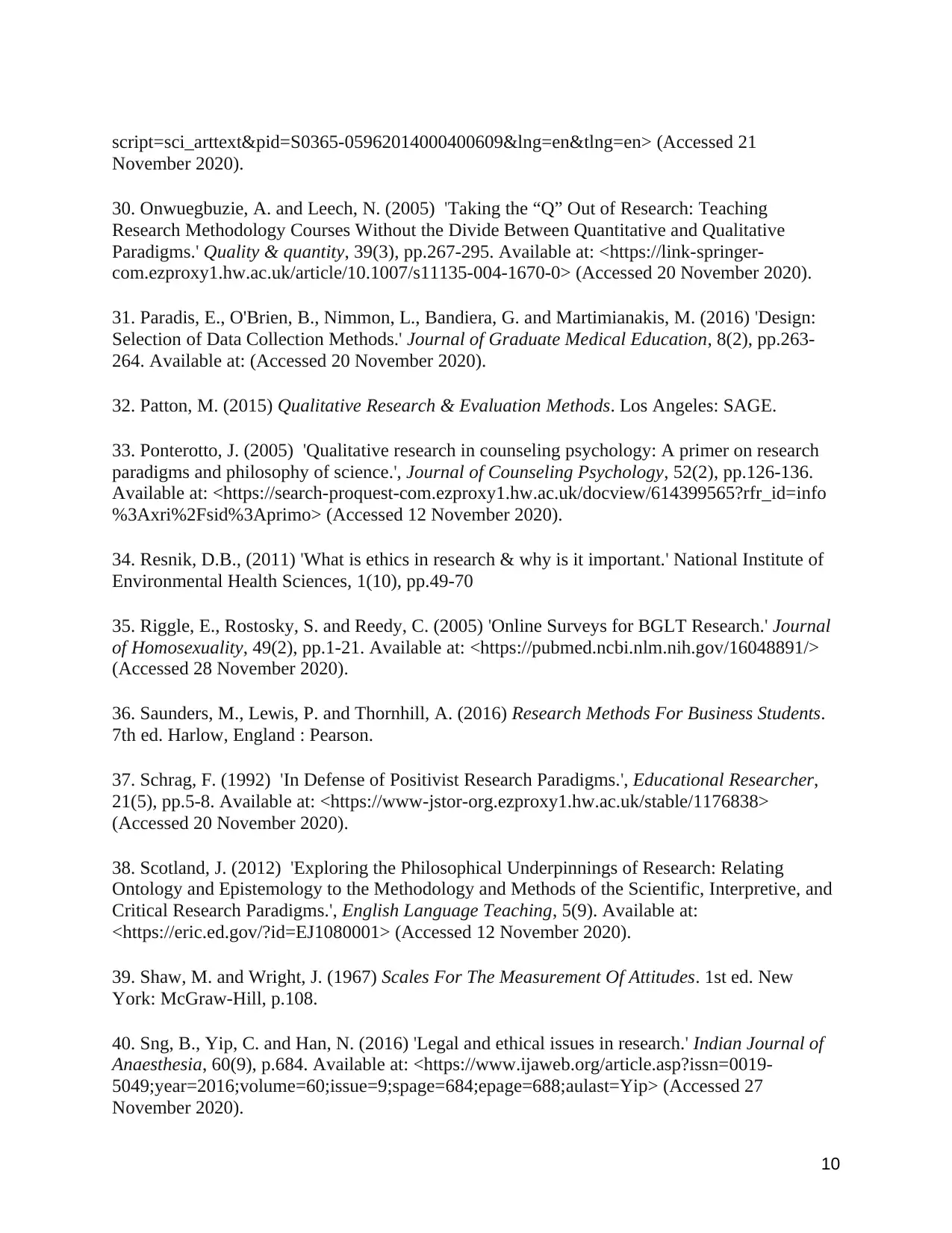
script=sci_arttext&pid=S0365-05962014000400609&lng=en&tlng=en> (Accessed 21
November 2020).
30. Onwuegbuzie, A. and Leech, N. (2005) 'Taking the “Q” Out of Research: Teaching
Research Methodology Courses Without the Divide Between Quantitative and Qualitative
Paradigms.' Quality & quantity, 39(3), pp.267-295. Available at: <https://link-springer-
com.ezproxy1.hw.ac.uk/article/10.1007/s11135-004-1670-0> (Accessed 20 November 2020).
31. Paradis, E., O'Brien, B., Nimmon, L., Bandiera, G. and Martimianakis, M. (2016) 'Design:
Selection of Data Collection Methods.' Journal of Graduate Medical Education, 8(2), pp.263-
264. Available at: (Accessed 20 November 2020).
32. Patton, M. (2015) Qualitative Research & Evaluation Methods. Los Angeles: SAGE.
33. Ponterotto, J. (2005) 'Qualitative research in counseling psychology: A primer on research
paradigms and philosophy of science.', Journal of Counseling Psychology, 52(2), pp.126-136.
Available at: <https://search-proquest-com.ezproxy1.hw.ac.uk/docview/614399565?rfr_id=info
%3Axri%2Fsid%3Aprimo> (Accessed 12 November 2020).
34. Resnik, D.B., (2011) 'What is ethics in research & why is it important.' National Institute of
Environmental Health Sciences, 1(10), pp.49-70
35. Riggle, E., Rostosky, S. and Reedy, C. (2005) 'Online Surveys for BGLT Research.' Journal
of Homosexuality, 49(2), pp.1-21. Available at: <https://pubmed.ncbi.nlm.nih.gov/16048891/>
(Accessed 28 November 2020).
36. Saunders, M., Lewis, P. and Thornhill, A. (2016) Research Methods For Business Students.
7th ed. Harlow, England : Pearson.
37. Schrag, F. (1992) 'In Defense of Positivist Research Paradigms.', Educational Researcher,
21(5), pp.5-8. Available at: <https://www-jstor-org.ezproxy1.hw.ac.uk/stable/1176838>
(Accessed 20 November 2020).
38. Scotland, J. (2012) 'Exploring the Philosophical Underpinnings of Research: Relating
Ontology and Epistemology to the Methodology and Methods of the Scientific, Interpretive, and
Critical Research Paradigms.', English Language Teaching, 5(9). Available at:
<https://eric.ed.gov/?id=EJ1080001> (Accessed 12 November 2020).
39. Shaw, M. and Wright, J. (1967) Scales For The Measurement Of Attitudes. 1st ed. New
York: McGraw-Hill, p.108.
40. Sng, B., Yip, C. and Han, N. (2016) 'Legal and ethical issues in research.' Indian Journal of
Anaesthesia, 60(9), p.684. Available at: <https://www.ijaweb.org/article.asp?issn=0019-
5049;year=2016;volume=60;issue=9;spage=684;epage=688;aulast=Yip> (Accessed 27
November 2020).
10
November 2020).
30. Onwuegbuzie, A. and Leech, N. (2005) 'Taking the “Q” Out of Research: Teaching
Research Methodology Courses Without the Divide Between Quantitative and Qualitative
Paradigms.' Quality & quantity, 39(3), pp.267-295. Available at: <https://link-springer-
com.ezproxy1.hw.ac.uk/article/10.1007/s11135-004-1670-0> (Accessed 20 November 2020).
31. Paradis, E., O'Brien, B., Nimmon, L., Bandiera, G. and Martimianakis, M. (2016) 'Design:
Selection of Data Collection Methods.' Journal of Graduate Medical Education, 8(2), pp.263-
264. Available at: (Accessed 20 November 2020).
32. Patton, M. (2015) Qualitative Research & Evaluation Methods. Los Angeles: SAGE.
33. Ponterotto, J. (2005) 'Qualitative research in counseling psychology: A primer on research
paradigms and philosophy of science.', Journal of Counseling Psychology, 52(2), pp.126-136.
Available at: <https://search-proquest-com.ezproxy1.hw.ac.uk/docview/614399565?rfr_id=info
%3Axri%2Fsid%3Aprimo> (Accessed 12 November 2020).
34. Resnik, D.B., (2011) 'What is ethics in research & why is it important.' National Institute of
Environmental Health Sciences, 1(10), pp.49-70
35. Riggle, E., Rostosky, S. and Reedy, C. (2005) 'Online Surveys for BGLT Research.' Journal
of Homosexuality, 49(2), pp.1-21. Available at: <https://pubmed.ncbi.nlm.nih.gov/16048891/>
(Accessed 28 November 2020).
36. Saunders, M., Lewis, P. and Thornhill, A. (2016) Research Methods For Business Students.
7th ed. Harlow, England : Pearson.
37. Schrag, F. (1992) 'In Defense of Positivist Research Paradigms.', Educational Researcher,
21(5), pp.5-8. Available at: <https://www-jstor-org.ezproxy1.hw.ac.uk/stable/1176838>
(Accessed 20 November 2020).
38. Scotland, J. (2012) 'Exploring the Philosophical Underpinnings of Research: Relating
Ontology and Epistemology to the Methodology and Methods of the Scientific, Interpretive, and
Critical Research Paradigms.', English Language Teaching, 5(9). Available at:
<https://eric.ed.gov/?id=EJ1080001> (Accessed 12 November 2020).
39. Shaw, M. and Wright, J. (1967) Scales For The Measurement Of Attitudes. 1st ed. New
York: McGraw-Hill, p.108.
40. Sng, B., Yip, C. and Han, N. (2016) 'Legal and ethical issues in research.' Indian Journal of
Anaesthesia, 60(9), p.684. Available at: <https://www.ijaweb.org/article.asp?issn=0019-
5049;year=2016;volume=60;issue=9;spage=684;epage=688;aulast=Yip> (Accessed 27
November 2020).
10
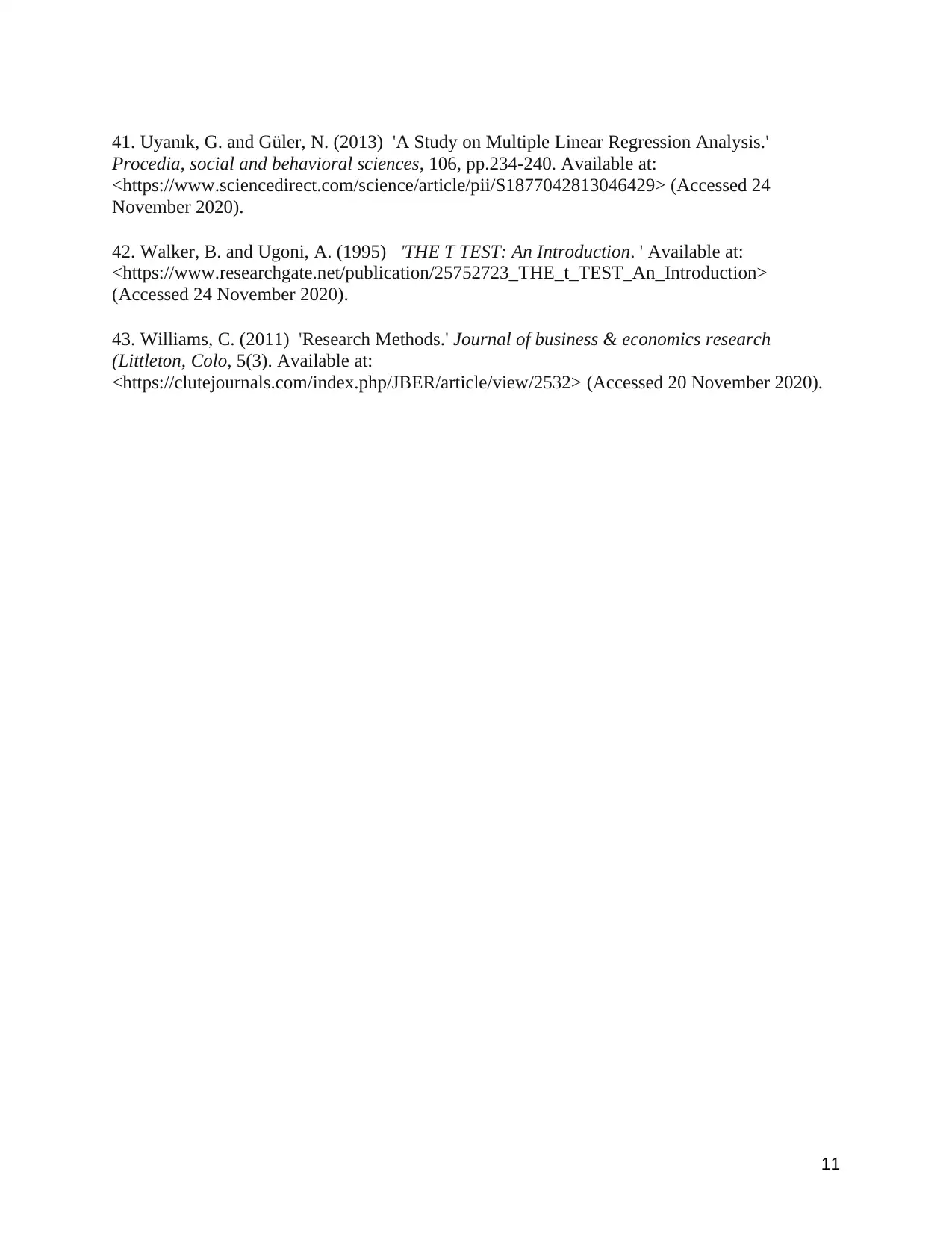
41. Uyanık, G. and Güler, N. (2013) 'A Study on Multiple Linear Regression Analysis.'
Procedia, social and behavioral sciences, 106, pp.234-240. Available at:
<https://www.sciencedirect.com/science/article/pii/S1877042813046429> (Accessed 24
November 2020).
42. Walker, B. and Ugoni, A. (1995) 'THE T TEST: An Introduction. ' Available at:
<https://www.researchgate.net/publication/25752723_THE_t_TEST_An_Introduction>
(Accessed 24 November 2020).
43. Williams, C. (2011) 'Research Methods.' Journal of business & economics research
(Littleton, Colo, 5(3). Available at:
<https://clutejournals.com/index.php/JBER/article/view/2532> (Accessed 20 November 2020).
11
Procedia, social and behavioral sciences, 106, pp.234-240. Available at:
<https://www.sciencedirect.com/science/article/pii/S1877042813046429> (Accessed 24
November 2020).
42. Walker, B. and Ugoni, A. (1995) 'THE T TEST: An Introduction. ' Available at:
<https://www.researchgate.net/publication/25752723_THE_t_TEST_An_Introduction>
(Accessed 24 November 2020).
43. Williams, C. (2011) 'Research Methods.' Journal of business & economics research
(Littleton, Colo, 5(3). Available at:
<https://clutejournals.com/index.php/JBER/article/view/2532> (Accessed 20 November 2020).
11
1 out of 12
Related Documents
Your All-in-One AI-Powered Toolkit for Academic Success.
+13062052269
info@desklib.com
Available 24*7 on WhatsApp / Email
![[object Object]](/_next/static/media/star-bottom.7253800d.svg)
Unlock your academic potential
© 2024 | Zucol Services PVT LTD | All rights reserved.





